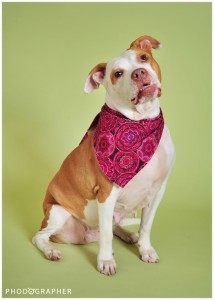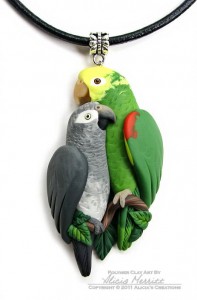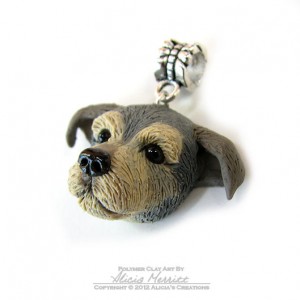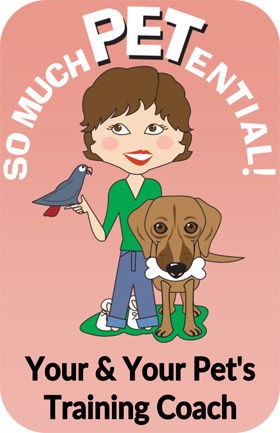Pets
Pitbull Lacy Teaches About Love And Forgiveness
I’d like to introduce you to Lacy, a sweet Pitbull who believes whole heartedly in the concept of pay-it-forward by freely giving of her love to those who have shown her kindness.
Sadly, she wasn’t always surrounded  by people who care. Lacy made headline news earlier this year when a Brown County farmer found her near skeletal frame under a pile of lumber, clinging to a life with an unknown future. Her emaciated body was near frozen from the harsh ice storm. She had a fractured skull, an ulcerated eye and a head swollen from infection.
by people who care. Lacy made headline news earlier this year when a Brown County farmer found her near skeletal frame under a pile of lumber, clinging to a life with an unknown future. Her emaciated body was near frozen from the harsh ice storm. She had a fractured skull, an ulcerated eye and a head swollen from infection.
Authorities figured her skinny 27 pound frame was discarded after she was likely used as practice for bigger, stronger dogs trained for illegal fighting. When Lacy was brought to the Brown County Animal Shelter, her teeth were filed down, her body was covered with old scars, and she needed surgeries to remove the remnants of bullets.
A grudge? What is that?
The hearts of animals just amaze me. Such a powerless victim of senseless brutality should have no reason to trust humans again. But here she is a beautiful, plumped up girl who is eager to find her forever home where she can share and embellish love.
While her story began in an ugly place where evilness and hatred surrounded her. Those who have come into her life since that frigid day that she almost didn’t survive have more than saved her life. They have taught her that there really is good in this world. There a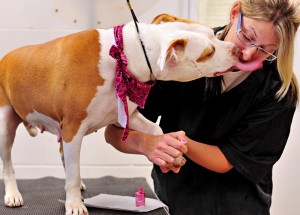 re people who care and who can be trusted, and who want to see her thrive. And to each person who shows her some kindness, she gladly pays back with dogs kisses.
re people who care and who can be trusted, and who want to see her thrive. And to each person who shows her some kindness, she gladly pays back with dogs kisses.
Lacy was a recently winner of Phodographer Carolyn Evans’ Extreme Doggie Makeover. Here she is being pampered by the groomer at Best Friends Pet Care of Cincinnati. And the happy studio picture below was taken by Carolyn to help Lacy find her forever home.
You can meet Lacy through the Adore-A-Bull Rescue group. You can even make her a part of her family.
And, if you do, I’d love to share your story.
House Vets for House Pets Celebrating 10 Years
Anderson’s House Vets for House Pets is hosting a 10th anniversary party this Saturday, October 6, from 11 am to 4 pm and you are invited.
 There will be free food, prizes, music, games for kids and dogs, and a tour that includes several educational work stations. You could win free boarding, Fit Club, free products, food from some of our favorite local restaurants, and more.
There will be free food, prizes, music, games for kids and dogs, and a tour that includes several educational work stations. You could win free boarding, Fit Club, free products, food from some of our favorite local restaurants, and more.
They are located at 8240 Beechmont Ave; Cincinnati, Ohio 45255.
Stopping Your Dog From Eating Poop
Please visit my pet behavior blog at http://www.SoMuchPETential.com/blog.
(Note: this is a past Hyde Park Living column)
A friend told me the other day her dog had adopted a very, well, unpleasant interest…or unpleasant to her anyway. He loves rolling in dog ‘poop’. Why on earth would any animal find eating dog poop something fun to do? And how can you put this horrible behavior to rest?
This actually is a common enough problem that if you look online, there are many websites and articles devoted to just this topic.
So, why would any animal eat poop? Well, let’s think about what we know about behavior. Behavior happens because it serves a purpose for the animal – to achieve something positive or reinforcing (from the perspective of the animal doing the behavior), or to move away from something negative. Given a choice animals tend to do things that are the most rewarding to them. And when a behavior has positive consequences, it is going to continue…even strengthen.
We may never truly know what our dog is thinking when he eats poop but we can hypothesize several positive consequences – sensory feedback (yes, a dog may actually like the taste of dog poop especially when he is hungry) or social feedback (maybe after eating dog poop, his favorite human becomes very animated in running away from him as an example), or it could be that he has some nutritional deficiency.
Punishing our dog for this behavior WILL NOT teach our dog what TO DO instead of the problem behavior and will not teach us how to find positive solutions; but it may create aggression, apathy, escape/avoidance behaviors or generalized fear. When we look at modifying a pet behavior using the most positive, least intrusive way we look at what we can do to change the environment so as to set our pets up for success. We do that by either changing the consequences to the behavior or changing the setting event (antecedent) for the behavior.
I spoke with Donna Hill, a Canadian dog trainer who uses only positive reinforcement strategies to train assistance dogs, about this recently.
Let’s look at both. We’ll start with the situation of your dog in your own yard. From a behavior analysis perspective, these are some potential scenarios: Possible antecedents – dog has access to poop, dog smells/sees poop. Behavior – dog eats poop. Possible positive consequences – tasty meal (I’ll never understand), reaction from human.
One way to manage the behavior is simply not giving your dog access to the poop in the first place. This would require you to always be watchful of your dog and either removing the poop right away (or removing your dog) or teaching your dog a strong drop it or leave it behavior. This isn’t always practical because many people have fenced yards and want to leave their dog outside unsupervised. Donna had this problem and learned that apples make poop taste bad. She eliminated her problem by simply adding a little apple to her dog’s diet, and thus making the consequence of eating poop no longer a pleasant experience. That solved her situation.
You also should make sure this nasty behavior is not due to a health issue. It’s always a good idea to have your dog examined by your vet to make sure the underlying cause is not a medical one.
If your dog is eating poop outside your yard, antecedent change is probably the simplest solution by simply not giving your dog access. Having your dog on a leash when outside your yard will not allow him to wander off and find that tasty treat. Teaching the ‘drop it’ or ‘leave it’ behavior will also allow you to call your dog off his drive toward the treat. Remember though that any new behavior should be taught in an environment with minimal distractions first (NOT when your dog is highly charged).
For some tips on teaching your dog the ‘drop it‘ cue, please see my blog post.
Alicia Merritt Creates Parrot Jewelry Out Of Love
NOTE: I have a new pet behavior blog located at http://www.SoMuchPETential.com/blog. Thanks!
Alicia Merritt has always loved animals. Growing up in the Philippines, she’s had some pretty unusual pets – goats, pigs, lizards and chickens. Well, that is, in addition to her cats and dogs.
Her fascination with parrots arrived when her cockatiel did. Alicia was 11 years old at the time. Since then, she has had numerous parrots and currently shares her home with two beautifully, loving, silly Solomon Island Eclectus Parrots.
Well, she also shares her home with three adopted poodles.
Alicia discovered her talent for polymer clay sculpture when she was having health issues and looking for something to do with her limited energy. I’ve admired her work for years. I’m enclosing a couple pictures of her animals. (Note that she specializes in birds. She charges more for custom dog sculptures.)
To see all of her pieces or inquire about custom work, please visit her website: http://www.parrotjewelry.com.
Pet Dominance: Myth or Fact?
NOTE: I have a new pet behavior blog located at http://www.SoMuchPETential.com/blog. Thanks!
(This one of my past Hyde Park Living columns.)
Many unwanted behaviors like pulling on a leash, growling, barking, or biting are blamed on dominance. “They’ve got that alpha dog thing going on.”
Well, as Susan Friedman, Ph.D., has taught me, dominance is nothing more than a label for a behavior – a description of  what we as humans ‘think’ explains the problem behaviors we have with our pet. The problem is, a label is simply nothing more than an intangible explanation that doesn’t even specify what the observable behavior is or the condition in which it is behaved. Behavior plus conditions is the smallest meaningful unit of behavior analysis. And, unfortunately a label ultimately leads to a self fulfilling prophecy because how we react and how our animal responds to our actions leads to stronger behaviors. Giving behaviors labels stops us from our search for finding a positive solution for modifying that behavior.
what we as humans ‘think’ explains the problem behaviors we have with our pet. The problem is, a label is simply nothing more than an intangible explanation that doesn’t even specify what the observable behavior is or the condition in which it is behaved. Behavior plus conditions is the smallest meaningful unit of behavior analysis. And, unfortunately a label ultimately leads to a self fulfilling prophecy because how we react and how our animal responds to our actions leads to stronger behaviors. Giving behaviors labels stops us from our search for finding a positive solution for modifying that behavior.
How does the self-fulfilling prophecy come to play in talking about the alpha dog? Well, a couple months back I wrote about the dangers of using a technique called flooding (a form of training in which the animal is exposed to an aversive stimulus with no possibility of escape until the stimulus no longer arouses anxiety – labeled as dominance – in the animal). One claim is that you should force your puppy onto its back, not letting him up until he stops resisting. Some may say that is teaching your dog to be submissive but behaviorists will say that is creating learned helplessness, and if you are looking to build a strong, positive relationship with your dog – that is not the way to do it.
I digressed. So, this ‘alpha dog’ concept – it stems from studies of wolf packs in the 1940s. Dr. Ian Dunbar, founder of the Association of Pet Dog Trainers: 1) Those studies were short term and focused only on the most obvious facet of wolf life – mainly hunting. 2) Researchers observed what are now known to be ritualistic displays and misinterpreted them. 3) Researchers made some wild extrapolations from their data.
The fact is, dogs are to wolves what chimpanzees are to humans. They became a separate species well over 100,000 years ago. In that time there has been domestication, co-evolution with humans and selective breeding.
Behaviorists like my teacher and mentor Susan Friedman, Ph.D., and trainers who I’ve studied from such as Steve Martin, Barbara Heidenrich, and Susan Garrett instead focus on setting animals up for success. They look at the specific behavior to be modified or taught in terms of the purpose that behavior serves the animal in its environment. They reinforce behaviors they want to see. And they empower animals by putting the power of choice in the animal’s control and simply modifying the consequences (and/or the antecedents) to make the desired behavior the best choice.
So, let me recap. If you really want your dog to do what you want him to do, stop labeling him as dominant and stop using the excuse that he is a pack leader alpha dog. (Or that you have to be the alpha dog.) Instead, see yourself as a teacher and your dog as your student. Every unwanted behavior is an opportunity to teach a new skill.

